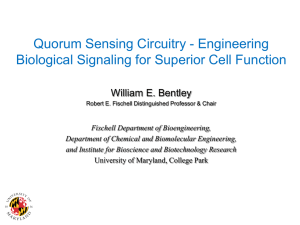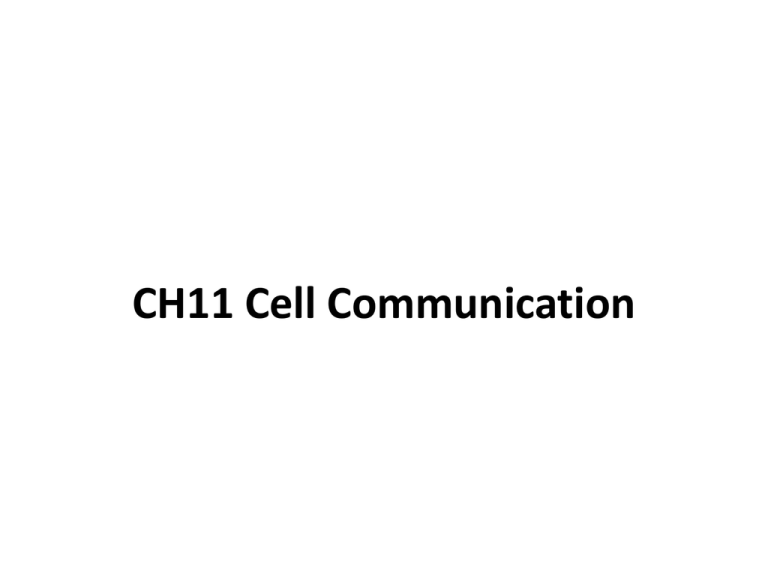
CH11 Cell Communication
VOCABULARY
directions: mark each term to indicate
if you know it, are unsure, or don’t.
amplify
communication
deleterious
elaborate
embryology
evolution
fluid mosaic model
mechanism
phosphorylation prophylactic
regulation response
signaling
signal molecule
specify
second
messengers
QUESTIONS
signal transduction quorum sensing IP3
G protein
generate a list to be answered today
Who
What
Where
When
Which
How
Why
communication
You know it is important.
What does it mean?
Brainstorm words related to “communication”.
Where on the cell does the
“communication” occur?
• “speaking” occurs through the production and
release of LIGANDS hormones or other chemical
messengers using the cells machinery, vesicles, and
exocytosis.
• “Listening” occurs by receptor proteins embedded
in the cell membrane and by way of signal
transduction pathways (domino effect of sorts) .
• “Reacting” occurs when specific enzymes become
activated (because of the signal transduction
pathway) and the cell performs a specific function.
How do cells communicate?
They are a lot like you… they use many different methods for
communicating and their “messages” can result in a variety of
responses. Process info via SIGNAL TRANSDUCTION PATHWAY
COMMUNICATION
Talking, listening, & responding.
Generate
information &
transmit
information
Receive
Information
Respond to
information
signal
transduction
pathway
Inhibitory or
excitatory
Cells communicate by generating, transmitting and receiving
chemical signals.
Big Idea 3:
Living systems store, retrieve,
transmit and respond to information
essential to life processes.
Big Idea 1:
The process of evolution drives the
diversity and unity of life.
The expression of genetic material controls cell
products, and these products determine the
metabolism and nature of the cell.
1) Gene expression is regulated by both
– 1)environmental signals and
– 2)developmental cascades or stages.
2) Cell signaling mechanisms can also modulate and
control gene expression.
3) Structure and Function in biology involve two
interacting aspects:
– 1) the presence of necessary genetic information and
– 2) the correct and timely expression of this information.
Cell communication processes share common
features that reflect a shared evolutionary history.
• Communication involves transduction of stimulatory or
inhibitory signals from other cells, organisms or the
environment.
• Correct and appropriate signal transduction processes are
generally under strong selective pressure.
• In single-celled organisms, signal transduction pathways
influence how the cell responds to its environment.
Examples:
– Use of chemical messengers by microbes to communicate with
other nearby cells and to regulate specific pathways in response
to population density (quorum sensing)
– Use of pheromones to trigger reproduction and developmental
pathways
– Response to external signals by bacteria that influences cell
movement
Figure 11.3
Communication among bacteria
QUORUM SENSING- bacteria
Can sense changes in density
And act appropriately.
1 Individual
rod-shaped
cells
2 Aggregation
in progress
0.5 mm
3 Spore-forming
structure
(fruiting body)
2.5 mm
Fruiting bodies
Figure 11.3a
1 Individual rod-shaped cells
Figure 11.3b
2 Aggregation in progress
Figure 11.3c
0.5 mm
3 Spore-forming structure
(fruiting body)
Figure 11.3d
2.5 mm
Fruiting bodies
A variety of intercellular and intracellular signal
transmissions mediate gene expression.
a. Signal transmission within and between cells mediates gene expression.
b. EXAMPLES:
• Cytokines regulate gene expression to allow for cell replication and
division.
YEAST
• Mating pheromones trigger mating gene expression in yeast.
BACTERIA
• Levels of cAMP regulate metabolic gene expression in bacteria.
PLANTS
• Ethylene (hormone) levels cause changes in the production of different
enzymes, allowing fruits to ripen.
• Gibberellin (hormone) causes seed germination.
ANIMALS
• Expression of the SRY gene triggers the male sexual development
pathway in animals.
• Signals come from cells or changes in their physical
environment:
– Chemicals (pheromones, hormones)
– Light electromagnetic radiation, touch, gravity
• Receptors are proteins embedded in the cell
membrane.
• Signal transduction pathways relay signals from
receptors to cellular responses.
• Responses include: specific enzyme activation
– Inhibitory response (via inhibitors)
– Excitatory response (via activators- coenzyme or cofactor)
Why do cells need to communicate?
• (unicellular) To be able to survive and reproduce
– Find food and water
– Escape/avoid danger
– Find mates
• (multicellular) To develop from a fertilized egg.
– Differentiation
– Programmed cell death (Apoptosis)
Figure 11.22
Effect of apoptosis during paw development in the mouse.
Interdigital tissue
Cells undergoing
apoptosis
Space between
1 mm
digits
Ex.Morphogens stimulate cell differentiation and development.
Figure 11.20
Apoptosis of a human white blood cell.
2 m
Once it engulfs bacteria it commits “cell suicide” by carefully
packaging its contents into multiple vesicles (membrane bound bags).
Figure 11.1
How does cell signaling trigger the desperate flight of this gazelle?
Have you ever been scared? What does your body do?
• The “fight or flight” response is signaled by
the hormone epinepherine or adrenaline.
• Causes changes to maximize ATP production
– the release of glucose from muscles and liver cells
– Increase in respiration depth and rate
– Increase in heart rate
Figure 11.16
Reception
Binding of epinephrine to G protein-coupled receptor (1 molecule)
Transduction
Inactive G protein
Active G protein (102 molecules)
Inactive adenylyl cyclase
Active adenylyl cyclase (102)
ATP
Cyclic AMP (104)
Inactive protein kinase A
Active protein kinase A (104)
Inactive phosphorylase kinase
Active phosphorylase kinase (105)
Inactive glycogen phosphorylase
Active glycogen phosphorylase (106)
Response
Glycogen
Glucose 1-phosphate
(108 molecules)
Cytoplasmic response to a signal: the stimulation of glycogen breakdown by epinephrine.
How is communication different btwn
single and multicellular organisms?
• In single-celled organisms, signal transduction pathways
influence how the cell responds to its environment.
whereas
• In multicellular organisms, signal transduction pathways
coordinate the activities within individual cells that support
the function of the organism as a whole.
– Temperature determination of sex in some vertebrate organisms
– DNA repair mechanisms
– Epinephrine stimulation of glycogen breakdown in mammals
How is communication different in
multicellular organisms?
• In multicellular organisms, cell-to-cell and environment-tocell chemical signaling pathways direct complex processes.
– Ex. cell and organ differentiation to whole organism
physiological responses and behaviors.
• Certain signal pathways involve direct cell-to-cell contact,
operate over very short distances, and may be determined
by the structure of the organism or organelle, including
– plasmodesmata in plants and
– receptor-to-recognition protein interaction in the vertebrate
immune system.
Figure 11.4
Plasma membranes
Gap junctions
between animal cells
Plasmodesmata
between plant cells
(a) Cell junctions
(b) Cell-cell recognition
Communication by direct contact between cells.
Which life forms use cell
communication?
• Cell-to-cell communication is ubiquitous in
biological systems, from archaea and bacteria to
multicellular organisms.
• The basic chemical processes by which cells
communicate are shared across evolutionary
lines of descent, and communication schemes are
the products of evolution.
• For cells to function in a biological system, they
must communicate with other cells and respond
to their external environment.
When did cell communication evolve?
• Cell-to-cell communication is a component of
higher-order biological organization and
responses.
• Communication evolved billions of years ago
among the most ancient bacteria.
OVERVIEW:
1) Cell communication evolved early in the history oflife.
• Cell-to-cell communication is essential for multicellular
organisms. The trillions of cells in a human or an oak
tree must communicate in order to develop from a
fertilized egg.
• Additional evidence for the evolutionary relatedness of
all life comes from discovering some universal
mechanisms of cellular regulation.
– Q: What molecular evidence suggests the unity of life on
Earth (descent from a common ancestor)?
• Knowledge of cell signaling mechanisms are answering
questions in medicine and biology in these areas:
embryological development, hormone action, cancer.
– Ex. Changes in p53 activity can result in cancer.
• Examples of signals that can be received by cells and
the possible responses:
– Changes in light duration lead to changes in plants
(dropping leaves, flowering)
– Light & phototropism (plant cell growth toward light)
– Gravity or touch effects plant growth (shoots away from
gravity, roots toward gravity)
b. Signal transmission within and
between cells mediates cell function.
• Main topic of cell “conversation” = SEX…
• Ex. YEAST Saccharomyces cerevisiae
• Mating pheromones in yeast trigger mating
genes expression and sexual reproduction.
• Q: How is the mating signal at the yeast cell
surface “transduced”, or changed, into a form
that brings about the cellular response of
mating?
• A: Signal Transduction Pathway
Figure 11.2
factor
Receptor
2 mating types
1 Exchange
of mating
factors
Each secretes
A mating factor
That binds to the other
Cell.
a
a factor
Yeast cell,
Yeast cell,
mating type a
mating type
2 Mating
a
3 New a/ cell
a/
Communication between mating yeast cells.
• Scientists think signaling mechanisms evolved
first in ancient prokaryotes and single celled
eukaryotes and were then adopted for new
uses by their multicellular descendants.
Figure 11.5
Local and long-distance cell signaling by secreted molecules in animals.
2) Communicating cells can be close together or far apart.
Local signaling
Long-distance signaling
Target cell
Secreting
cell
Local regulator
diffuses through
extracellular fluid.
(a) Paracrine signaling
Electrical signal
along nerve cell
triggers release of
neurotransmitter.
Endocrine cell
Neurotransmitter
diffuses across
synapse.
Secretory
vesicle
Target cell
is stimulated.
Blood
vessel
Hormone travels
in bloodstream.
Target cell
specifically
binds
hormone.
(b) Synaptic signaling
(c) Endocrine (hormonal) signaling
Local signaling: paracrine or synaptic involves…secreting molecules
short distances. Ex. neurotransmitters.
Long distance (hormonal) signaling… secretes hormones for signaling
at greater distances. Known as ENDOCRINE signaling.
Figure 11.6-3
3) The 3 stages of cell signaling:
EXTRACELLULAR
FLUID
1 Reception
CYTOPLASM
Plasma membrane
2 Transduction
3 Response
Receptor
Activation
of cellular
response
Relay molecules in a signal transduction
pathway
Signaling
molecule
#1 reception: ligand binding to receptor
#2 transduction: relay molecules employed
#3 response: activation of cellular response
THE DETAILS:
RECEPTION & THE INITIATION OF
TRANSDUCTION
Signal transduction pathways link signal reception
with cellular response.
• 1) Signaling begins with the recognition of a
chemical messenger, a ligand, by a receptor
protein.
• Different receptors recognize different chemical
messengers, which can be
– peptides,
– small chemicals or
– proteins, in a specific one-to-one relationship.
• 2) A receptor protein recognizes signal
molecules, causing the receptor protein’s
shape to change,
• which initiates transduction of the signal.
• Examples:
– G-protein linked receptors
– Receptor tyrosine kinases
– Ligand-gated ion channels
– The Exception: Non-membrane protein receptors
Figure 11.7a
G-protein linked receptor
Signaling molecule binding site
Segment that
interacts with
G proteins
G protein-coupled receptor
Figure 11.7b
G-protein linked receptors
G protein-coupled
receptor
Plasma
membrane
Activated
receptor
1
Inactive
enzyme
GTP
GDP
GDP
CYTOPLASM
Signaling
molecule
Enzyme
G protein
(inactive)
2
GDP
GTP
Activated
enzyme
GTP
GDP
Pi
3
Cellular response
4
Explain in in your own words what is happening during steps 1-4.
Figure 11.7c
RECEPTOR TYROSINE KINASES
Signaling
molecule (ligand)
Explain steps 1-4 in your own words.
Ligand-binding site
helix in the
membrane
Signaling
molecule
Tyrosines
CYTOPLASM
Tyr
Tyr
Tyr
Tyr
Tyr
Tyr
Receptor tyrosine
kinase proteins
(inactive monomers)
1
Tyr
Tyr
Tyr
Tyr
Tyr
Tyr
Tyr
Tyr
Tyr
Tyr
Tyr
Tyr
Dimer
2
Activated relay
proteins
3
Tyr
Tyr
P Tyr
Tyr P
P Tyr
Tyr P
Tyr
Tyr
P Tyr
Tyr P
P Tyr
Tyr P
Tyr
Tyr
P Tyr
Tyr P
P Tyr
Tyr P
6
ATP
Activated tyrosine
kinase regions
(unphosphorylated
dimer)
6 ADP
Fully activated
receptor tyrosine
kinase
(phosphorylated
dimer)
4
Inactive
relay proteins
Cellular
response 1
Cellular
response 2
Figure 11.7d
LIGAND GATED ION CHANNELS
Explain steps 1-3 in your own words.
1
3
2
Signaling
molecule
(ligand)
Gate
closed
Ions
Gate closed
Gate
open
Plasma
Ligand-gated
membrane
ion channel receptor
Cellular response ex. Muscle Cell contractions.
Cellular
response
Figure 11.9-1
Hormone
(testosterone)
The exceptions:
Non membrane
protein
Receptors
EXTRACELLULAR
FLUID
Plasma
membrane
Receptor
protein
Are found in the
cytoplasm.
are activated by
Steroid hormones.
Activate
transcription
Factors in the
nucleus.
DNA
NUCLEUS
CYTOPLASM
Figure 11.9-2
The exceptions:
Non membrane
protein
Receptors
Hormone
(testosterone)
EXTRACELLULAR
FLUID
Plasma
membrane
Receptor
protein
Hormonereceptor
complex
Are found in the
cytoplasm.
are activated by
Steroid
hormones.
Activate
transcription
Factors in the
nucleus.
DNA
NUCLEUS
CYTOPLASM
Why is is that steroid
Hormones can pass
Through the cell membrane?
Figure 11.9-3
Hormone
(testosterone)
The exceptions:
Non membrane
protein
Receptors
EXTRACELLULAR
FLUID
Plasma
membrane
Receptor
protein
Hormonereceptor
complex
Are found in the
cytoplasm.
are activated by
Steroid hormones.
Activate
transcription
Factors in the
nucleus.
DNA
NUCLEUS
CYTOPLASM
And nuclear envelope?
Figure 11.9-4
Hormone
(testosterone)
The exceptions:
Non membrane
protein
Receptors
EXTRACELLULAR
FLUID
Plasma
membrane
Receptor
protein
Hormonereceptor
complex
Are found in the
cytoplasm.
are activated by
Steroid hormones.
DNA
mRNA
Activate
transcription
Factors in the
nucleus.
NUCLEUS
CYTOPLASM
Steroids are lipids.
Like dissolves like.
Are not repelled by the
Hydrophobic tails of the
Phospholipid bilayer.
Figure 11.9-5
Hormone
(testosterone)
The exceptions:
Non membrane
protein
Receptors
EXTRACELLULAR
FLUID
Plasma
membrane
Receptor
protein
Hormonereceptor
complex
Are found in the
cytoplasm.
are activated by
Steroid hormones.
DNA
mRNA
Activate
transcription
Factors in the
nucleus.
NUCLEUS
CYTOPLASM
New protein
SIGNAL TRANSDUCTION PATHWAYS
• 1) Signal transduction is the process by which
a signal is converted to a cellular response.
CELLULAR RESPONSES TO SIGNALS
1) In response to a signal, a cell may regulate activities in
the cytoplasm or transcription in the nucleus.
2) Elaborate pathways amplify and specify the cells
response to signals.
• Signaling cascades relay signals from receptors to cell
targets, often amplifying the incoming signals, with the
result of appropriate responses by the cell.
• Second messengers are often essential to the function of
the cascade.
• Examples of second messengers:
– Cyclic AMP cAMP
– inositol triphosphate IP3
Figure 11.11
Adenylyl cyclase
Phosphodiesterase
H2O
Pyrophosphate
P Pi
ATP
cAMP
Why is the molecule called “cyclic” AMP not just AMP?
AMP
Figure 11.12
First messenger
(signaling molecule
such as epinephrine)
1st
messenger?
2nd messenger?
G protein-coupled
receptor
Adenylyl
cyclase
G protein
GTP
ATP
cAMP
Second
messenger
Protein
kinase A
Cellular responses
Figure 11.14-1
EXTRACELLULAR
FLUID
Signaling molecule
(first messenger)
G protein
DAG
GTP
G protein-coupled
receptor
Phospholipase C
PIP2
IP3
(second messenger)
IP3-gated
calcium channel
What is the 1st messenger?
What is the 2nd messenger?
Endoplasmic
reticulum (ER)
CYTOSOL
Ca2
Figure 11.14-2
EXTRACELLULAR
FLUID
Signaling molecule
(first messenger)
G protein
DAG
GTP
G protein-coupled
receptor
Phospholipase C
PIP2
IP3
(second messenger)
IP3-gated
calcium channel
Endoplasmic
reticulum (ER)
CYTOSOL
Ca2
Ca2
(second
messenger)
What is the “other”
2nd messenger?
Figure 11.14-3
EXTRACELLULAR
FLUID
Signaling molecule
(first messenger)
G protein
DAG
GTP
G protein-coupled
receptor
Phospholipase C
PIP2
IP3
(second messenger)
IP3-gated
calcium channel
Endoplasmic
reticulum (ER)
CYTOSOL
Various
proteins
activated
Ca2
Ca2
(second
messenger)
Cellular
responses
= Amplified response
3) Major mechanisms of signal transduction
pathways:
• Protein modifications (Methylation)
– Epigenetic control of the genome changes the
signaling process.
• Phosphorylation cascades in which a series of
protein kinases add a phosphate group to the
next protein in the cascade sequence
4) Certain small molecules and ions are key
components of signaling pathways.
Figure 11.15
Growth factor
Reception
Receptor
Phosphorylation
cascade
Transduction
CYTOPLASM
Inactive
transcription
factor
Active
transcription
factor
P
Response
DNA
Gene
NUCLEUS
mRNA
Figure 11.10
Signaling molecule
Receptor
Activated relay
molecule
Inactive
protein kinase
1
Active
protein
kinase
1
Inactive
protein kinase
2
ATP
ADP
P
Active
protein
kinase
2
PP
Pi
Inactive
protein kinase
3
ATP
ADP
Pi
Active
protein
kinase
3
PP
Inactive
protein
P
ATP
P
ADP
PP
Pi
Active
protein
Cellular
response
Figure 11.17
RESULTS
formin
Fus3
Wild type (with shmoos)
CONCLUSION
1 Mating
factor
activates
receptor.
Mating
factor G protein-coupled
Shmoo projection
forming
receptor
Formin
P
Fus3
GDP
GTP
2 G protein binds GTP
and becomes activated.
Fus3
Actin
subunit
P
Phosphorylation
cascade
Fus3
Formin
Formin
P
4 Fus3 phosphorylates
formin,
activating it.
P
3 Phosphorylation cascade
activates Fus3, which moves
to plasma membrane.
Microfilament
5 Formin initiates growth of
microfilaments that form
the shmoo projections.
Figure 11.18
Signaling
molecule
Receptor
Relay
molecules
Response 1
Cell A. Pathway leads
to a single response.
Activation
or inhibition
Response 2
Response 3
Cell B. Pathway branches,
leading to two responses.
Response 4
Cell C. Cross-talk occurs
between two pathways.
Response 5
Cell D. Different receptor
leads to a different
response.
Changes in signal transduction
pathways can alter cellular response.
• 1) Conditions where signal transduction is blocked or defective can be
deleterious, preventative, or prophylactic.
• Diseases: Diabetes, heart disease, neurological disease, autoimmune
disease, cancer, cholera
Ex. Carcinogens can mutate the P53 (tumor supressor gene). The gene
normally codes for a protein that controls the cell cycle.
• Effects of: Effects of neurotoxins, poisons, pesticides
Ex. Neurotoxin BOTOX blocks the neurotransmitter acetyl choline from
binding to muscle cells so it induces paralysis.
• Drugs: Hypertensives, Anesthetics, Antihistamines and Birth Control Drugs
QUIZ
Signal Overview
Indicate where each of the labels
should appear in the figure.
•
•
•
•
Receptor
Relay molecules
Transduction
Activation of cellular response
• Signaling molecule
• Response
• Reception
Figure 11.6-3
3) The 3 stages of cell signaling:
EXTRACELLULAR
FLUID
1 Reception
CYTOPLASM
Plasma membrane
2 Transduction
3 Response
Receptor
Activation
of cellular
response
Relay molecules in a signal transduction
pathway
Signaling
molecule
#1 reception
#2 transduction
#3 response
Which of the following best
describes a signal transduction
pathway?
A) binding of a signal molecule to a cell protein
B) catalysis mediated by an enzyme
C) sequence of changes in a series of molecules
resulting in a response
D) binding of a ligand on one side of a membrane that
results in a change on the other side
E) the cell’s detection of a chemical or mechanical
stimulus
Which of the following best
describes a signal transduction
pathway?
A) binding of a signal molecule to a cell protein
B) catalysis mediated by an enzyme
C) sequence of changes in a series of molecules
resulting in a response
D) binding of a ligand on one side of a membrane that
results in a change on the other side
E) the cell’s detection of a chemical or mechanical
stimulus
A steroid hormone binds to an
intracellular receptor. When it does, the
resulting complex is able to do which of
the following? Why?
A. open channels in the membrane for other
substances to enter
B. open channels in the nuclear envelope for
cytoplasmic molecules to enter
C. mediate the transfer of phosphate groups to/from
ATP
D. act as a transcription factor in the nucleus
E. make water-soluble molecules able to diffuse across
membranes
A steroid hormone binds to an intracellular
receptor. When it does, the resulting complex
is able to do which of the following? Why?
A. open channels in the membrane for other
substances to enter
B. open channels in the nuclear envelope for
cytoplasmic molecules to enter
C. mediate the transfer of phosphate groups to/from
ATP
D. act as a transcription factor in the nucleus
E. make water-soluble molecules able to diffuse across
membranes
Without consulting the figure in
your text, describe what is
happening at each of the stages
labeled 2 through 5.
In reactions mediated by protein kinases,
what does phosphorylation of successive
proteins do to drive the reaction?
A.
B.
C.
D.
E.
make functional ATP
change a protein from its inactive to its active form
change a protein from its active to its inactive form
alter the permeability of the cell’s membranes
produce an increase in the cell’s store of inorganic
phosphates
In reactions mediated by protein kinases,
what does phosphorylation of successive
proteins do to drive the reaction?
A.
B.
C.
D.
E.
make functional ATP
change a protein from its inactive to its active form
change a protein from its active to its inactive form
alter the permeability of the cell’s membranes
produce an increase in the cell’s store of inorganic
phosphates
What would happen to a cell whose
receptors remain bound to the
signal molecule(s)?
Which of the following is an
example of signal amplification?
A) catalysis of many cAMP molecules by several
simultaneously binding signal molecules
B) activation of 100 molecules by a single signal
binding event
C) activation of a specific gene by a growth factor
D) activation of an enzyme molecule
E) utilization of a second messenger system
Which of the following is an
example of signal amplification?
A) catalysis of many cAMP molecules by several
simultaneously binding signal molecules
B) activation of 100 molecules by a single signal
binding event
C) activation of a specific gene by a growth factor
D) activation of an enzyme molecule
E) utilization of a second messenger system
How could cancer result from a
defect in apoptosis?
One of the important outcomes of apoptosis
is protection of neighboring cells. Which of
the following is responsible?
A.
B.
C.
D.
E.
cell shrinkage and blebbing
destruction of the cell’s DNA
formation of numerous vesicles to be digested
action of tyrosine kinases
activation of specific proteins
One of the important outcomes of apoptosis
is protection of neighboring cells. Which of
the following is responsible?
A.
B.
C.
D.
E.
cell shrinkage and blebbing
destruction of the cell’s DNA
formation of numerous vesicles to be digested
action of tyrosine kinases
activation of specific proteins
What are the similarities among
the following?
• G protein-coupled receptors
• receptor tyrosine kinases
• ion channel receptors



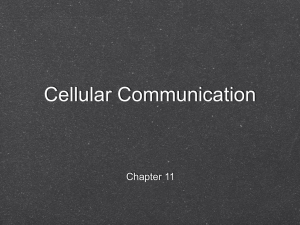
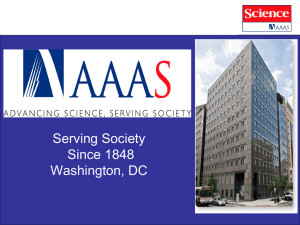
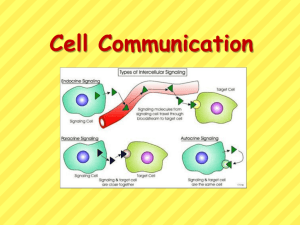
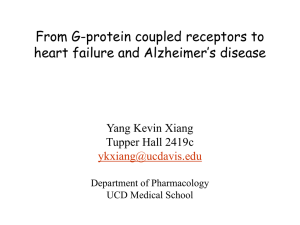
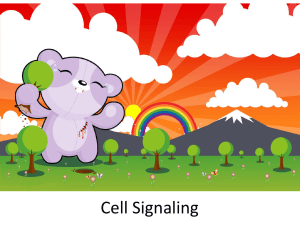
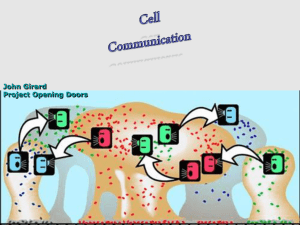

![Shark Electrosense: physiology and circuit model []](http://s2.studylib.net/store/data/005306781_1-34d5e86294a52e9275a69716495e2e51-300x300.png)

